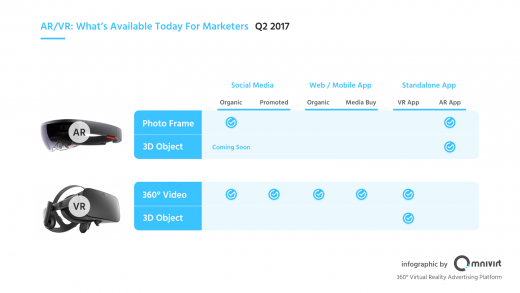What Facebook F8’s AR/VR announcements mean for marketers
What Facebook F8’s AR/VR announcements mean for marketers

Last week, Facebook once again created buzz in the AR/VR industry with a series of announcements at the F8 Developer Conference. With 2 billion active users on Facebook and a mission to be the leader of next wave technologies, there is no doubt that the industry is watching Facebook’s movements in this space closely.
See also: Adobe sees VR as the next great travel disruptor
You may have heard about the broad range of AR/VR discussions this past week, from the first AR camera platform to the first Facebook social VR app. However, with marketers looking to take advantage of these new interactive mediums it is becoming increasingly difficult to understand when and how to employ these new technologies.
Is AR better for marketing than VR? Or is it the other way around? When should I use AR? When should I use VR? What do these executions look like? These are just some of the questions we receive from our customers on a weekly basis. As someone very passionate about this space, I would love to share some of my thoughts and insights below:

Use VR for immersive storytelling
When to use AR and when to use VR?
The simple answer is AR allows you to enhance the world around you while VR immerses you in a world that has been fully created for you. From a marketers perspective, both mediums have their distinct advantages, but which to use relies on what your creative objective is. How important is your audience’s real-world surrounding to the story-arc you are looking to deliver? Or is your objective to immerse this viewer in a narrative that you have created for them?
As mentioned, AR can enhance the world around the viewer, but in doing so it often sacrifices story and narrative to create space for the real world context. In contrast, VR brings its audience into a fully immersive experience where the marketer and storyteller can take that viewer through its narrative arc.
Let’s take a look at a hypothetical example: Imagine you are releasing the new Iron Man film. What would an AR experience look like and what would a VR experience look like?
For AR, you could invite your audience to take selfies of themselves dressed as the Iron Man character or you could all of a sudden have Tony Stark standing in your room. With VR, you can bring your audience into the film and have them actively participate as a character, maybe flying next to Iron Man as he returns to his beautiful mansion property. As you can see, the same movie can employ both technologies to market the film as each technology has a different focus.
But as a marketer it is important to understand after investing in this new form of creative, how will you get people to see it?
Where are the eyeballs for AR and VR today?
For marketers, getting eyeballs and engagement on your creative is of paramount importance. The reality for AR is that the majority of digital information we consume today doesn’t require your real-world surroundings. We mostly consume information through displays, not lenses. As a result, distribution for AR is still quite limited. Summary table below:

As you can see above, while both mediums are still emerging, AR is still in its early days. In contrast, VR has witnessed the emergence of a standard format in the 360° VR Video that has given marketers the ability to deliver these content experiences to the eyeballs they need.
What do we see in the future of AR and VR?
There is no doubt that both AR and VR will be great computing platforms, but what remains to be seen is how marketers can fully take advantage of these technologies. From my perspective, VR appears to be following a trend familiar to the world of media. Just as newspapers transitioned to the more visual medium of television, it feels only natural that the next consumption platform would be even more interactive and engaging, hence VR.
In parallel, AR appears to be following a trend we have seen around querying information. Just as we are seeing an evolution from text search to voice search. AR can open up a new way to get enhanced information through a smartphone lens.
As an advertising platform who is directly involved with marketers and publishers, we are very excited for the future to come.
OmniVirt is 360 Video and Virtual Reality advertising platform founded by former Google and YouTube employees. The company has received funding from top venture capitalists including Andreessen Horowitz, Greycroft, BDMI, Horizon Media, First Round Capital and many others. OmniVirt’s technology distributes 360° VR across top publisher websites like The New York Times, AOL, Time Inc, Gannet, Wall Street Journal, Vice Media and more. These experiences are customizable and interactive, with detailed performance reporting showcasing where audiences are engaging in the immersive experience. The company has powered multiple high-profile campaigns for clients like Toyota, Infiniti, Samsung, Chevron, Universal Pictures and Johnnie Walker.

This article is part of our Virtual Reality series. You can download a high-resolution version of the landscape featuring 431 companies here
The post What Facebook F8’s AR/VR announcements mean for marketers appeared first on ReadWrite.
(53)



